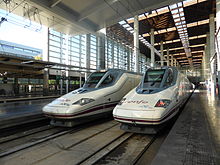
Madrid is served by highly developed transport infrastructure. Road, rail and air links are vital to maintain the economic position of Madrid as a leading centre of employment, enterprise, trade and tourism, providing effective connections with not only other parts of the region, but also the rest of Spain and Europe as a whole. Three quarters of a million people commute into the city to work,[1]: 66 and these and other local travellers have available a high-capacity metropolitan road network and a well-used public transport system based on the Metro, the Cercanías local railways, and a dense network of bus routes.[1]: 62–4
In terms of longer-distance transport, Madrid is the central node of the system of autovías and of the high-speed rail network (AVE), which has brought major cities such as Seville and Barcelona within 2.5 hours travel time.[1]: 72–75 Madrid is also home to the Madrid-Barajas Airport, the fourth largest airport in Europe.[1]: 76–78 Madrid's location at the centre of the peninsula makes it a major logistical base.[1]: 79–80